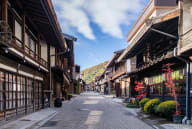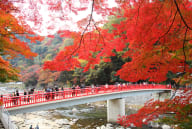
Okinawa Tropical sunshine meets a melange of cultures
A Culinary Journey in Okinawa
Okinawa, Japan's southernmost prefecture, is a tropical paradise renowned for its stunning beaches, vibrant culture, and unique culinary traditions. The warm climate and rich soil of this island chain create ideal conditions for cultivating various distinctive agricultural products.
Okinawa, which once flourished as the Ryukyu Kingdom (1429 – 1879) boasts its own unique culture, its cuisine is a delightful blend of Japanese, Chinese, and Southeast Asian influences, reflecting its historical role as a cultural crossroads. The region is famous for its healthy and flavourful dishes, often incorporating fresh, locally grown ingredients like Goya (bitter melon), purple sweet potatoes, and an array of tropical fruits. Okinawa’s pork - particularly the local Agu pork, is celebrated for its rich taste and tenderness.
Signature dishes of Okinawa include Goya-champuru, a stir-fry featuring bitter melon, tofu, and pork, and Rafute - succulent braised pork belly cooked in soy sauce, brown sugar, and awamori (a local distilled spirit). Soki soba, a comforting noodle soup topped with tender pork ribs, is another beloved local specialty. Additionally, the region’s tropical climate allows for the production of unique beverages such as Okinawan Shikuwasa (Okinawan lime) juice and Awamori (Okinawan distilled liquor, made from rice).
Immerse yourself in the culinary wonders of Okinawa, where each dish tells a story of the island's rich cultural tapestry and natural abundance.
Soki Soba (Okinawa-style soup noodles)

What it is (ingredients)
Soki Soba is a beloved Okinawan dish featuring thick wheat noodles in a rich, savoury broth. The star ingredient is "Soki," or braised pork spareribs, simmered with sugar and soy sauce until tender and flavourful. The soup has a complex flavour based on pork and bonito, with chicken added in some areas. Garnished with green onions, red pickled ginger, and sometimes fish cake, Soki Soba offers a delightful combination of textures and flavours that reflect Okinawa's unique culinary heritage.
History/Origin
The origins of Okinawan noodle dishes can be traced back to the Ryukyu Kingdom, where the fusion of Chinese and Japanese culinary influences shaped the local food culture. Initially introduced as a meal to entertain Chinese envoys, the popularity of noodle dishes grew, leading to an increase in noodle shops throughout the Meiji period (1868 - 1912). It was during the Taisho period (1912 - 1926) that Soki soba became more accessible to the general public. The dish was further refined in the Showa period (1926 - 1989) through continuous adjustments to better suit Okinawan tastes.
Where You Can Eat
Soki Soba can be found in local restaurants and eateries throughout Okinawa. Many establishments, from small family-run shops, to larger restaurants, offer their own variations of this classic dish. For an authentic experience, seek out eateries that specialize in traditional Okinawan cuisine, where the recipes are often passed down through generations.
When to Eat
This versatile dish can be enjoyed year-round, making it a favourite for both locals and visitors. Whether you're looking for a hearty meal to warm you up in the cooler months, or a satisfying dish to enjoy after a day at the beach, Soki Soba is perfect for any occasion.
Indulge in the rich, comforting flavours of Soki Soba and experience a taste of Okinawa's vibrant culinary tradition!
Beni-imo tart (Purple sweet potato tart)

What it is (ingredients)
Beni-imo tart is a delightful Okinawan dessert made from Beni-imo, a local purple sweet potato known for its vibrant colour and natural sweetness. This tart features a buttery pastry crust filled with a smooth, creamy, Beni-imo filling. The purple sweet potatoes are mashed and combined with sugar, butter, and cream to create a rich, velvety texture. The result is a visually stunning and delicious tart that captures the unique flavours of Okinawa.
History/Origin
Beni-imo has been a staple in Okinawan agriculture for centuries. Originally brought to Okinawa from China, where it was introduced from Spain in the 14th century, these sweet potatoes thrived in the island's subtropical climate and nutrient-rich soil. They are rich in vitamins, potassium, and fibre, earning their reputation as an Okinawan superfood. The creation of the Beni-imo tart is relatively recent – first emerging in 1986 as a way to showcase this beloved local ingredient in the form of appealing, modern dessert. Over the years, it has become a symbol of Okinawan creativity and culinary pride, gaining popularity both locally and internationally.
Where You Can Eat
You may come across Beni-imo tarts in various bakeries, cafes, and souvenir shops throughout Okinawa Prefecture. Many local bakeries and sweets shops offer their own versions of this tart, often beautifully packaged, making it a popular gift or souvenir. You can also find it in specialty stores that focus on Okinawan products, ensuring you get an authentic taste of the island.
When to Eat
This delightful tart can be found year-round, making it a perfect treat for any season. Its rich yet refreshing flavour makes it perfect as a dessert after meals, a sweet snack with tea or coffee, or a special treat to celebrate special occasions.
Savour the distinct taste of Beni-imo tart and experience the genuine sweetness of Okinawan culture.
Goya-champuru : Fried bitter melon with tofu and egg

What it is (ingredients)
Goya-champuru is a quintessential Okinawan stir-fry dish featuring Goya (bitter melon), tofu, egg, and often pork or Spam. The dish is seasoned with soy sauce and sometimes a dash of bonito flakes for an added umami punch. Goya's unique bitterness is balanced by the mild tofu and the richness of the egg, creating a harmonious blend of flavours and textures that highlight the island's local produce.
History/Origin
Goya-champuru has its roots in Okinawa's agricultural traditions, where bitter melon has long been cultivated for its health benefits. The term "Champuru" means "something mixed" in Okinawan dialect, reflecting the dish's eclectic blend of ingredients. This hearty and nutritious stir-fry became a staple of the Okinawan diet, especially during times of scarcity when locals needed to make the most of available ingredients. Over the years, Goya-champuru has come to symbolize the resilience and resourcefulness of Okinawan cuisine, celebrated for its ability to turn humble ingredients into delicious and nourishing meals.
Where You Can Eat
Goya-champuru can be found in a variety of settings across Okinawa, from local Izakaya (Japanese-style dining bars) and family-run restaurants, to high-end dining establishments specializing in local cuisine.
When to Eat
This versatile dish is suitable for any time of year, especially perfect for summer. It's believed that the bitter taste of Goya helps to expel heat from the body, supports a healthy stomach, and combats summer fatigue. Its refreshing yet hearty qualities make it perfect for both lunch and dinner, and it is often served of as part of a larger meal alongside other traditional Okinawan dishes.
Experience the unique flavour of Goya-champuru, and discover just how bitter the bitter gourd can be!































































